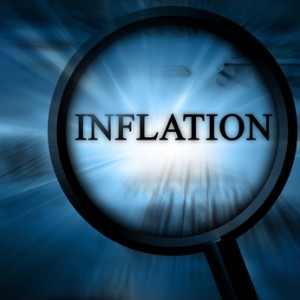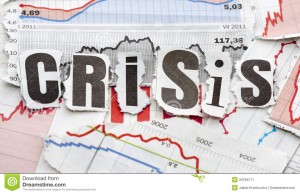WHAT IS INFLATION?
Inflation means a general and a sustained rise in prices, and as money is the yardstick of measuring prices, a rise in the general price level automatically means a loss in the value of money. This is in confirmation with the fact that anything in excess is always less valuable. The value of money in turn, lies in the amount of goods and services it can buy, and when these become dearer, the same amount of money can buy a lesser amount of these goods and services. This is how the purchasing power of money declines.
CAUSES OF INFLATION
In this world of dualities, even the price of anything in a market is decided on the basis of two factors: The supply of that thing and the demand for it. Thus, if we consider the price of a pen, it is determined by how many people are willing and able to purchase it and how many pens are available in the market. Similarly the overall price level in the economy is determined by the aggregate demand and aggregate supply in the economy. Aggregate demand (AD) is the demand for the goods and services (total output) in the economy at a particular price level by three different entities: Households, business firms and the government, whereas aggregate supply (AS) consists of the total amount of output which firms are willing to supply in the economy and it is determined by the cost of producing that output.
Thus we arrive at the two major causes of inflation. Inflation can be fuelled by the following two factors:
- Demand pull inflation
- Cost push inflation.
All other determinants of inflation can be clubbed under the above two broad factors.
- Demand pull Inflation:
Whenever aggregate demand is in excess of aggregate supply, prices shoot upward. There is not enough output which can be distributed among all those who demand it, and this is where rising prices enter the picture to push some buyers out of it.
Aggregate demand consists of the following components:
a) Consumption demand
b) Investment demand
c) Government expenditure
d) Export demand
- A rise in any of these three components e.g. consumers demanding more for consumption purposes, firms requiring more inputs for their production, government spending more to meet military requirements and exporters enjoying good demand for their products abroad; will lead to both increase in total output and prices, for producers to take full advantage of the rise in demand.
- Here sometimes the supply bottlenecks are larger, where the short term supply does not increase immediately with increase in demand (inelastic short-term supply).
- A variety of reasons can be responsible for this, few of them being inability of firms to immediately find skilled labour or the required raw material needed to increase production. Thus in such cases the rise in prices can be greater than the rise in output.
- Eventually the economy will reach the potential level of output which is the maximum level of output or GDP that a country can achieve over a period of time (There is a limit to the output due to natural, institutional and technological constraints), and where all the resources in the economy are fully employed.
- Thus, here if aggregate demand rises even further, an inflationary gap is created, which means that the excess of demand over supply is filled in by rise in prices.
Rise in Government expenditure:
Government may adopt an expansionary fiscal policy, which ends up boosting the consumption expenditure of households instead of strengthening the country’s infrastructure and building its capacity to produce more. This can occur when the government’s policies put more money in the hands of the people or boost their purchasing power by raising minimum wages, providing huge subsidies, etc. Thus galloping consumption demand by households outruns the snail-paced rise in output, leading to inflation.
The Indian government which has been carrying a an enormous subsidy burden (fuel, fertilizer, food and interest subsidies forming its pillars) on its shoulders, has artificially kept the prices of many essential items low, thus attracting a lot more demand for the subsidized items than is due to them. When these bounds of price controls are released (high time they must be, to reduce the fiscal deficit) the prices of the erstwhile subsidized items will go sky-rocketing. Even those who could have afforded these items had their prices not been regulated in the first place will also have to do without them for some time, until the demand cools down. This rationing of prices results in suppressed inflation, which is usually accompanied by black-marketing, profiteering, hoarding and corruption.
Increase in money supply:
Money supply is the total amount of money in the economy which mainly consists of the currency in circulation and bank deposits.Increase in the money supply contributes in raising aggregate demand in the following manner:
An expansion in the money supply means an increase in currency in circulation and in the bank reserves which cause a reduction in interest rates and in the lending activity of banks. The easy and relatively cheaper availability of credit puts more money in the hands of the people. This money is spent on consuming more goods and services which increases demand and hence prices. No doubt, this cheap credit finds its way into investments, but if resources cannot be flexibly employed or have reached the stage of full employment, increased claim on them bids up their prices. It is in this context that the following statement best describes inflation.
Fiscal deficit and inflation:
High fiscal deficit has been said to be one of the reasons behind inflation. Government finances its difference between revenue and expenditure by raising funds from the public. When it is unable to repay its debt obligations, the central bank of the country comes to its rescue. It buys the government debt by printing more currency, which expands the money supply in the country, with inflation closely following at its heels.
Click here for government certification in Accounting, Banking & Finance





9 Comments. Leave new
Good job@
Thorough revision for Macro Economics.
Very well written one..
so interesting!
well written
Well researched and beautifully presented 🙂
well researched and informative!!
nice articulation Ashwini 🙂
Well elaborated!
Well Researched One 😀
COntent and presentation 😀
5 on 5 😀 GOod 😀